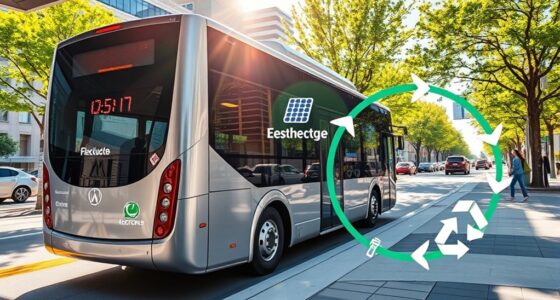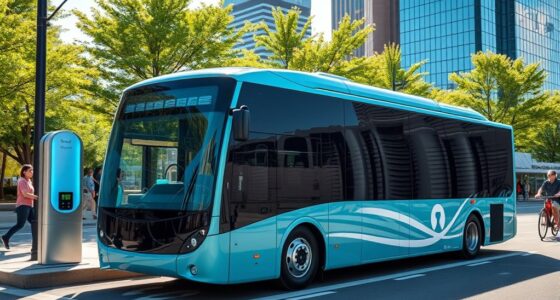Urban Heat Islands can indirectly harm electric buses by raising ambient temperatures, which reduce battery efficiency, speed up degradation, and increase operational costs. Higher temperatures also boost energy demand for cooling, stressing the power grid and increasing greenhouse gas emissions. Implementing mitigation strategies like green roofs and reflective surfaces helps lower city temperatures, improving bus performance and environmental impacts. To learn how these measures create a more sustainable transit system, keep exploring the effects further.
Key Takeaways
- UHI mitigation reduces ambient temperatures, enhancing electric bus battery efficiency and extending vehicle lifespan.
- Cooler urban environments decrease cooling energy demand for buses and infrastructure, lowering overall emissions.
- Lower urban temperatures lessen strain on power grids, supporting cleaner electricity generation for buses.
- Reducing UHIs decreases greenhouse gas emissions from energy consumption, indirectly benefiting climate change mitigation.
- Implementing UHI strategies fosters sustainable cities, indirectly improving electric bus performance and environmental impacts.

Urban heat islands (UHIs) intensify the challenges of rising temperatures in cities, making it harder for residents and infrastructure to cope. When temperatures soar, the need for effective thermal regulation becomes critical. High temperatures increase the demand for cooling systems, forcing buildings to work harder and consume more energy. This not only raises utility costs but also strains the power grid, leading to potential outages and increased emissions from fossil fuel-based electricity generation. Electric buses, often touted for their eco-friendliness, are part of the solution, but their benefits are intertwined with how well urban environments manage heat. If cities don’t address UHIs, the added heat impacts the electric bus systems’ energy efficiency, reducing their environmental advantages.
Urban heat islands reduce electric bus efficiency and increase energy demands in cities.
In hot urban settings, electric buses may face challenges in maintaining ideal battery performance and range. Elevated temperatures can accelerate battery degradation, leading to reduced lifespan and increased replacement costs. Conversely, in cooler conditions, batteries tend to perform better and last longer. This variability underscores the importance of designing cities that promote thermal regulation, such as green roofs, reflective pavements, and increased tree cover. These measures help lower ambient temperatures, directly improving the energy efficiency of electric buses and other cooling-dependent infrastructure. When the environment stays cooler, buses use less energy to operate, making their operation more sustainable and cost-effective.
Furthermore, cities that implement strategies to combat UHIs can see a significant reduction in overall energy consumption. Reducing urban heat not only decreases the cooling demand for buildings but also minimizes the need for additional cooling in electric buses’ charging stations. This creates a positive feedback loop—less heat means less energy spent on cooling, which in turn reduces greenhouse gas emissions. Electric buses, when integrated into these cooler, more sustainable urban landscapes, operate more efficiently, extending their range and decreasing the frequency of charging cycles. This enhances their viability as a clean transportation option, helping cities meet their environmental goals more effectively.
Addressing UHIs isn’t just about comfort; it’s a strategic move to maximize the benefits of electric transportation. By prioritizing thermal regulation measures, you help ensure that electric buses remain energy-efficient and environmentally friendly. Cooler cities mean less strain on the power grid, lower operational costs, and better battery performance. Ultimately, combating urban heat islands creates a healthier, more resilient urban environment—one where electric buses can truly serve as a sustainable transportation solution, reducing emissions and improving quality of life for residents.
Frequently Asked Questions
How Do Urban Heat Islands Affect Local Air Quality?
Urban heat islands worsen local air quality by increasing temperatures, which hinders urban cooling efforts and promotes the formation of air pollution, especially ground-level ozone. When temperatures rise, it accelerates chemical reactions that create harmful pollutants. You can help reduce this effect by supporting green infrastructure and cooling strategies. These actions not only promote urban cooling but also help lower air pollution, making your environment healthier and more comfortable.
What Are the Long-Term Economic Benefits of Electric Buses?
Switching to electric buses is like planting a forest of savings. Over time, you’ll see significant cost savings on fuel and maintenance, freeing funds for other projects. Plus, this shift creates new jobs in manufacturing, maintenance, and infrastructure development, boosting local economies. Long-term, your community benefits from cleaner air and reduced greenhouse gases, making the investment worthwhile. Embrace electric buses, and you’ll foster economic growth and environmental health simultaneously.
Can Electric Buses Operate Effectively During Extreme Weather Conditions?
Electric buses can operate effectively during extreme weather conditions, but their battery performance depends on proper thermal management. In very cold weather, batteries may lose capacity, reducing range, but advanced thermal management systems help maintain ideal temperatures. Similarly, extreme heat can cause overheating, so cooling systems are essential. With these measures in place, electric buses stay reliable, ensuring consistent service despite harsh weather conditions.
How Do Urban Heat Islands Influence Public Transportation Usage?
Imagine the city as a giant oven, making public transportation feel like a hot, uncomfortable ride. Urban heat islands raise temperatures, reducing urban cooling and passenger comfort. As the heat intensifies, fewer people choose buses, fearing discomfort. To keep riders coming, you need to improve urban cooling strategies, ensuring transit remains comfortable and accessible despite the heat. This way, public transport stays a cool, reliable way to get around.
Are There Specific Cities Leading in Electric Bus Adoption?
You’ll find that cities like Shenzhen, Los Angeles, and Bogotá are leading in electric bus adoption. These adoption leaders implement strong city initiatives to promote clean transit, making electric buses more accessible and popular. By prioritizing sustainable transportation, these cities set a great example for others aiming to reduce urban heat islands’ impact and improve air quality. Their proactive measures help accelerate electric bus adoption and create healthier urban environments.
Conclusion
By thoughtfully integrating electric buses into urban environments, you’re gently guiding cities toward a more harmonious balance. While the subtle warmth of heat islands may persist, your efforts help mitigate their impact, fostering a more comfortable and sustainable atmosphere. Embracing these changes encourages a refined evolution in urban living, where progress whispers softly alongside tradition. Ultimately, your choices contribute to a more elegant coexistence between human activity and the delicate urban ecosystem.









